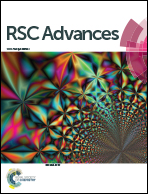A porous nano-adsorbent with dual functional groups for selective binding proteins with a low detection limit
Abstract
In this study, porous silica nanoparticles functionalized with a thiol group (SiO2–SH NPs) were synthesized via a one-pot method. Subsequently, iminodiacetic acid was modified, and further adsorption of Ni2+ ions was conducted to obtain a SiO2–S/NH–Ni nano-adsorbent. Then, transmission electron microscopy (TEM), scanning electron microscopy (SEM), Fourier transform infrared (FT-IR) spectroscopy, thermogravimetric analysis (TG) and X-ray diffraction (XRD) were employed to characterize its morphology and composition. The results indicate that the SiO2–S/NH–Ni nano-adsorbent is porous, has an average diameter of 77.1 nm and has a small porous structure of about 3.7 nm in the silica skeleton. The Brunauer–Emmett–Teller (BET) surface area and total pore volume were 537.2 m2 g−1 and 3.3 cm3 g−1, respectively, indicating a large BET surface area. The results indicate that the as-prepared SiO2–S/NH–Ni nano-adsorbent would be suitable to selectively and efficiently bind His-tagged proteins from an E. coli cell lysate. The SDS-PAGE results show that the as-prepared nano-adsorbent presents specifically to both His-tagged CPK4 and His-tagged TRX proteins, indicating the nano-adsorbent can be used to effectively separate His-tagged proteins and is universal to all His-tagged fusion proteins. We also found that the as-prepared nano-adsorbent exhibits a low detection limit (1.0 × 10−7 mol L−1) and a strong regeneration ability based on four regeneration experiments that were particularly suited to the separation of His-tagged proteins.



 Please wait while we load your content...
Please wait while we load your content...